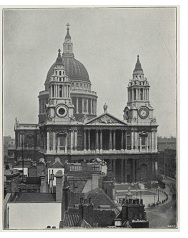|
London Sights to See - St. Paul's Cathedral
|
For over three hundred years, St Paul's Cathedral has served as one of
the enduring symbols of
London, a role it richly deserves. Completed in 1708, the ediface created by the master, Sir Christopher Wren,
is recognized the world over by its large dome and classical architecture.
 The fame of the dome is particularly ironic since the plans, third in succession after two rejected models, didn't call for one. Wren took
advantage of a clause in the commission permitting him to only make "ornamental" changes. The fame of the dome is particularly ironic since the plans, third in succession after two rejected models, didn't call for one. Wren took
advantage of a clause in the commission permitting him to only make "ornamental" changes.
So, you might NOT be surprised to learn, or maybe you will, that the large dome, visible from several parts of London far away, is just an ornament. In its interior is a much smaller
dome directly underneath, and, between the two, a large cone-shaped structure supports the 850-ton lantern.
Outside, astride the large dome are two towers and an extraordinary
classical facade. Though it forms the entrance, the view is less
familiar since photographs typically concentrate on the famous dome,
which lies on the other side. The west side offers an especially good
view. From here, visitors can take in the columns and the clock tower.
Whether viewing from outside or in, though, there are several outstanding features and dozens of smaller ones of interest.
One of the more popular interior features is the Whispering Gallery.
The result of the way sound waves move within an arched structure,
someone can stand at one corner and whisper and be heard far away in
the gallery. It can be reached by an athletic climb up 259 spiral
steps. Most find the effect woth the effort.
Someone standing far away beneath the opposite side of an arch can
still hear plainly what was said. Unfotunately, there are often several
pairs trying this at once. The sound is clearest if you can find a time
when no one else is also testing the effect.
Peculiarities of sound aside, the main interest lies less with physics
and more with art. One example is the 20-foot oak model representing
Wren's second major attempt at gaining approval for a design. Another
is the large pipe
organ, commissioned in 1694 and still functional.
Several other functional, yet artistic, elements are around the
cathedral. One, Wren's memorial, contains an epitaph from his son. It
reads, "Lector, si monumentum requiris circumspice." Translation: from
the Latin: "Reader, if you seek his monument, look around."
Many other plaques, carvings, statues and other memorials to the
powerful and famous of London's past are within the cathedral: in the
south transept Admiral
Nelson, in the north aisle the Duke of Wellington.
There's also a memorial in the south choir aisle of the poet John Donne, Dean of
St. Paul's before the current building was erected. The disastrous London fire of 1666,
destroyed the original. Almost ten years elapsed before construction
was begun, followed by more than another 30 until completion. That
gives some idea of how construction projects were carried out 300 years
ago.
Undergoing a £40 million ($71 million) restoration to
celebrate it's 300-year anniversary, many of the building's surfaces have been
cleaned and restored. Now is an especially good time to pay a visit.
The Cathedral is easy to spot and also easy to reach via the London
Underground, i.e. 'the tube' or subway. Exit at St Paul's station.
St. Paul's Cathedral
St Paul's Churchyard
London
EC4M 8AD
Phone: 020 7246 8350
More
Sights to See in London
Sitemap
Cities of the World
|

